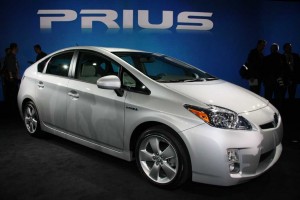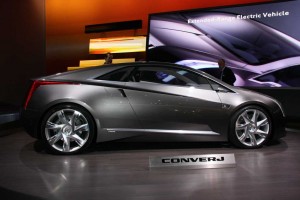Over the past year, we’ve seen the theme of fuel efficiency becoming more and more important to the auto shows in Europe.
Detroit took this theme to a much more defined mode. ‘Electrifying’, ‘An electric future’, ‘GM plans could charge up the state’, were the major headlines of the Detroit newspapers reporting on the presentations of the Big Three during the North American Internation Auto Show’s two media days.
But in November, at the LA Auto Show, the Big Three did not prove to be very determined to build electric vehicles. They each had a couple of hybrid versions on the road or in the pipeline, but electric cars….no! Well, maybe I have to explain the difference between the European classification and the American.
What about the Chevy Volt, GM’s first electric vehicle? I would say indeed, the Volt was unveiled two years ago, in Detroit, with much hoopla — and the designation of being an extended range electric vehicle. GM did a brilliant job in communicating to the world that the ‘electric Volt’ would be the company’s salvation. But to be honest, in Europe and Japan, the Volt is not an electric vehicle in the true sense of the term. An electric car runs solely on an electric motor. As soon as there is a gasoline engine combined with an electric one, it is a hybrid.
But that does not change the fact that a true electric, mass produced vehicle is still a bit far away. And that’s largely because there are still some issues to address with respect to the new lithium-ion batteries, such as weight and size and safety – never mind cost. Because of this, Toyota postponed the introduction of the new generation Prius nearly a year and unveiled the 2009 model in Detroit. And the new Prius still does not use LIon batteries.
BMW put a lithium-ion battery pack in the new Mini E. The pack consists of 5,088 lithium-ion cells, grouped in 48 modules, that are packaged in three units. Together with a cooler, the li-on battery adds some 400 lbs. to the weight of the Mini and uses up the area of the rear seats.
Each cell is isolated, so that if one overheats, it does not affect the neighbour cells, and is less likely to cause a fire. The package is complex – and large, consuming the entire area where you would normally have the rear seats. Some 500 Electric Mini’s are being planned for tests and will be useful for the R&D of a a plug-in electric powertrain to be built in the future by BMW, as part of Project-i, and is due to reach the markets in 2015. By that time, the engineers foresee the stack of batteries to be as flat as magazines, so that they can be placed anywhere in a car.
There are more small cars, like the Mitsubishi MIEV, the first EV by a major carmaker actually in production. The car has been on the Japanese market now for three months and Mitsubishi plansto sell 2,000 units this year, 4,000 in 2010 and 10,000 in 2011. Those numbers give an indication that the electric vehicle needs more time. And there will be the issues of reclycling batteries, electricity production and the infrastructure for plug-ins.
The questions is whether the various electrics shown by Detroit’s Three, such as the Cadillac Converj, the Chrysler 200C EV and the Dodge Circuit EV will ever go into production –whatever the manufacturers proclaim. Far more likely are Japanese and European EVs, such as the one promised by Nissan, for 2010, and the Toyota FT-EV, the latter based on the iQ minicar that will hit the wordwide markets this year. Also look for a low-volume series using the 2010 Mercedes B-Class, and based on the automaker’s BlueZero Concept, which also made its debut in Detroit, this month.
There are plenty of political reasons why the theme in Detroit, this year, was electrification. Whether the industry follows through is another matter, entirely. Ironically, the biggest push into battery technology may come from the newest of global makers, the Chinese. With that country’s leaders desperate to reduce endemic pollution, there’s been strong support given makers like BYD, which brought the E6 — with its lithium ferrous phosphate batteries reportedly delivering 250 miles range – to the Detroit show. The global push charge is on. The question is, when it comes to battery cars, who will take the lead?



The BYD electric E6– I heard you talk on NPR about the Chinese company that started development of LION batteries for the auto market years ago. Where can I get info on the company? Thanks.